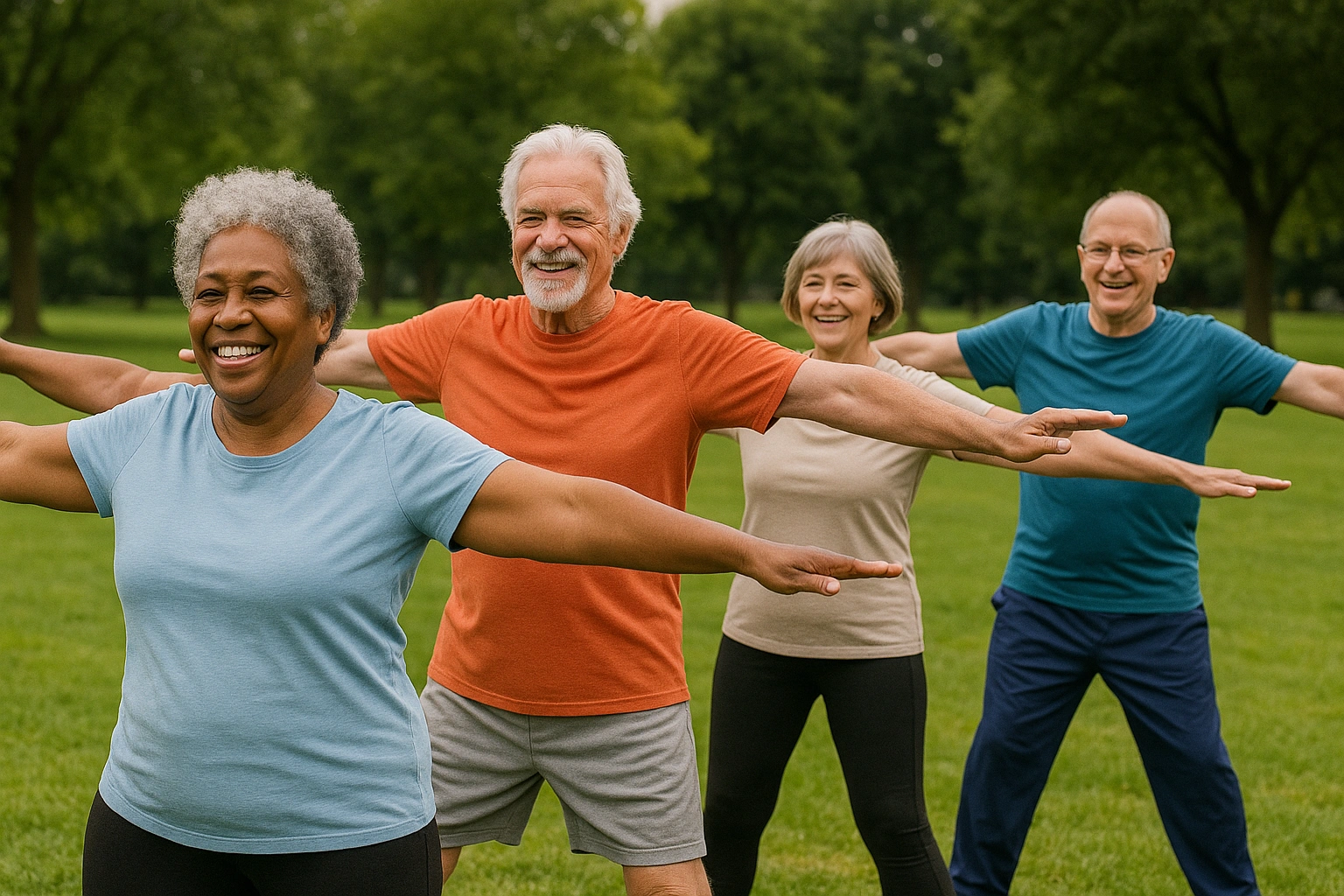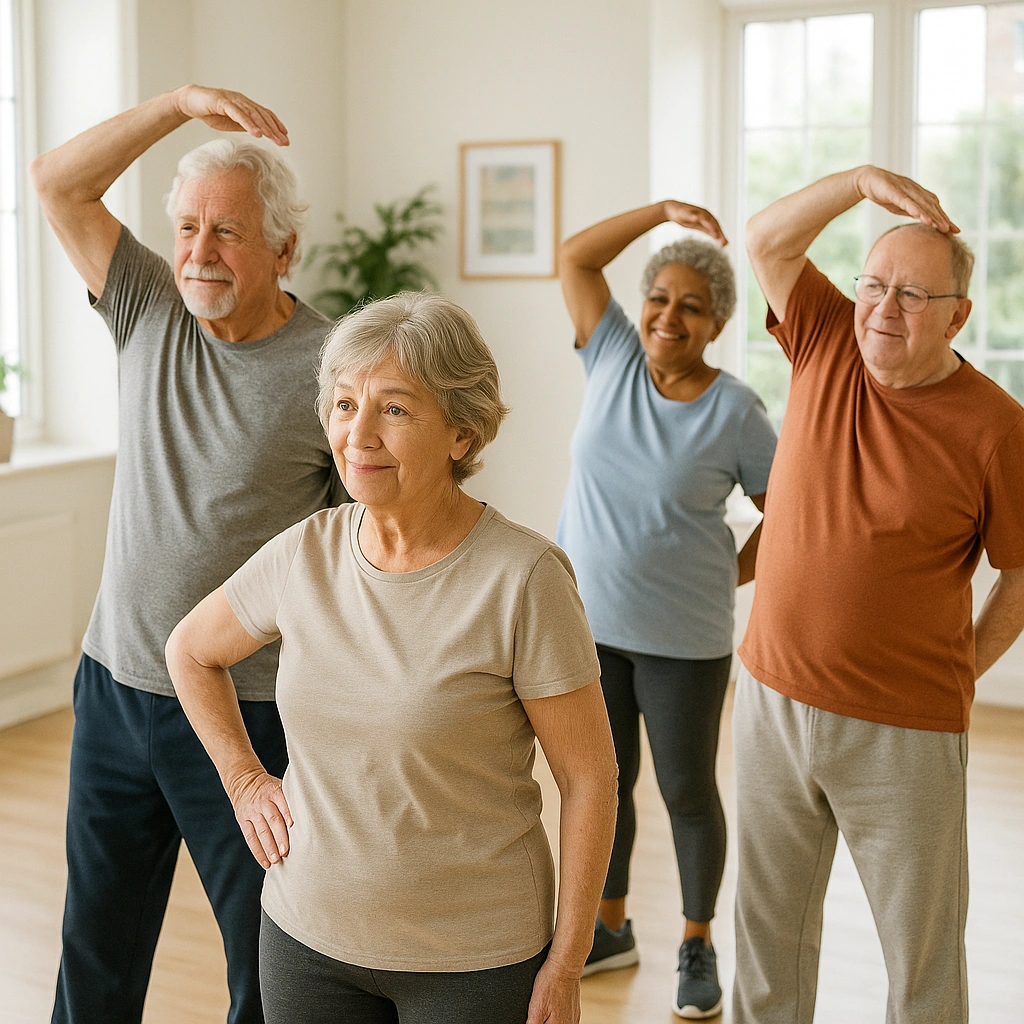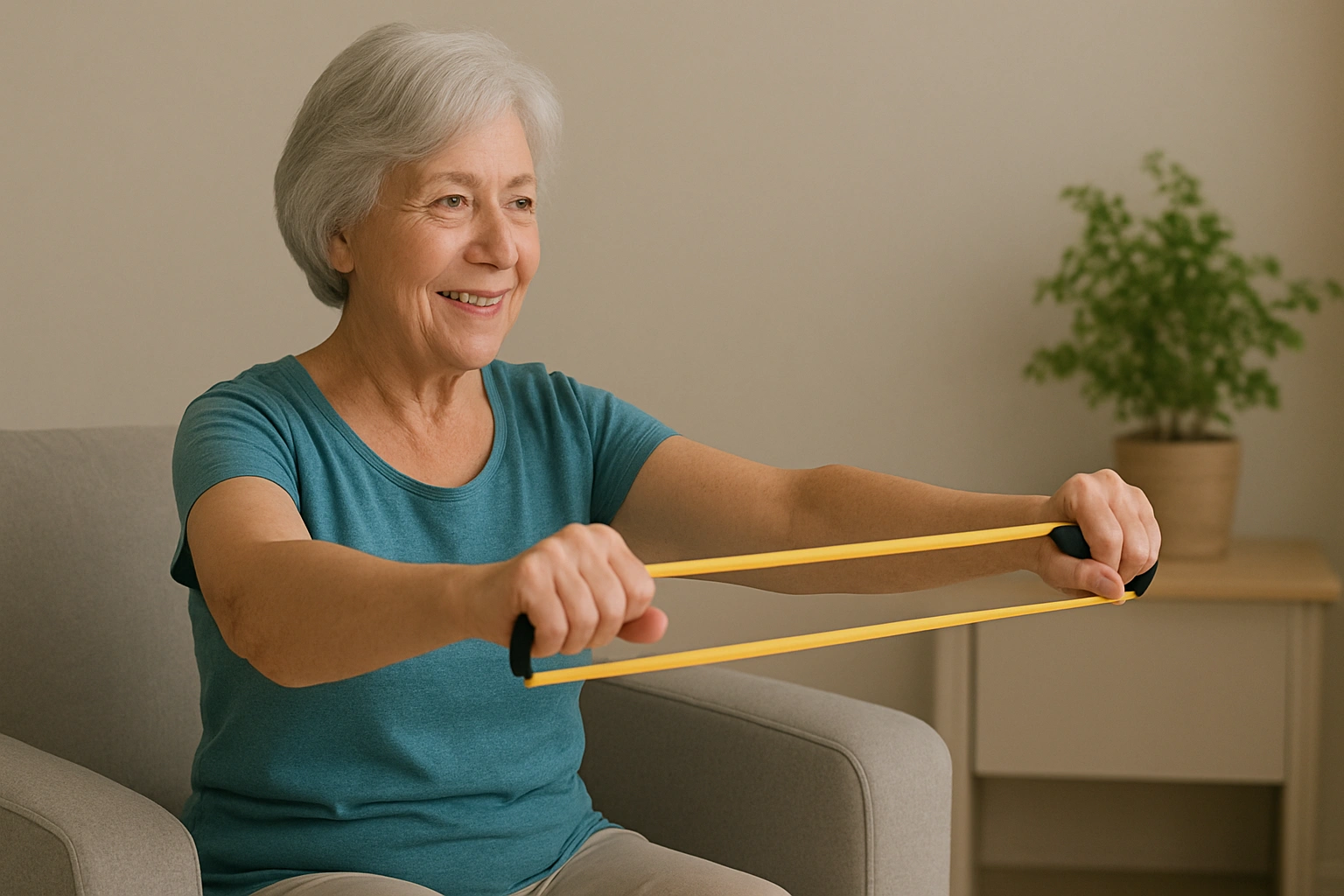
What if the key to maintaining your independence, sharpening your mind, and feeling more energetic wasn’t a pill, but a simple movement? The answer often lies in fitness routines for seniors that are easy to adapt and sustain over time. For millions of seniors, the fear of losing mobility can be a daily concern, yet fitness routines for seniors are proven to reduce that risk and build confidence. According to the CDC, regular physical activity is one of the most important things you can do for your health as you age, and fitness routines for seniors make that guidance both practical and achievable. By following fitness routines for seniors consistently, you’re not just preserving mobility—you’re actively investing in a healthier, more independent future.
This guide is designed to demystify exercise and provide simple, effective fitness routines for seniors that anyone can follow. You don’t need a gym membership or fancy equipment to start enjoying the benefits of fitness routines for seniors that improve balance, strength, and flexibility. After reading, you will have a clear understanding of the best exercises for your body, along with fitness routines for seniors that can be adjusted to your pace and comfort. With these fitness routines for seniors, you’ll have a practical plan to move safely, build confidence, and embrace a healthier lifestyle every day.
What is Senior-Focused Fitness?
Senior-focused fitness isn’t about running marathons or lifting heavy weights. It’s about engaging in safe, effective physical activity designed to enhance the quality of life for older adults. The goal is to improve strength, balance, endurance, and flexibility—the four pillars that support an active and independent lifestyle.
In 2025, the approach has evolved beyond just “staying active.” It’s now a science-backed strategy to combat age-related physical decline. As highlighted by healthcare experts, the trend is toward functional fitness—exercises that mimic everyday movements, like getting up from a chair or carrying groceries. This makes daily life easier and safer. Data from Statista shows a growing interest in low-impact and at-home fitness solutions, perfectly aligning with the needs of the senior population.
Why Consistent Exercise is a Game-Changer for Seniors
Incorporating regular movement into your life is an investment with unparalleled returns, and fitness routines for seniors make this step easier to follow. The benefits extend far beyond physical strength, as fitness routines for seniors also nurture mental clarity, emotional balance, and overall resilience. When practiced consistently, fitness routines for seniors can help maintain independence, reduce the risk of chronic illness, and improve daily energy levels. That’s why embracing fitness routines for seniors is one of the most important choices you can make for lasting well-being.
Enhance Mobility and Independence
Regular exercise strengthens muscles and lubricates joints, making it easier to perform daily tasks like walking, climbing stairs, and reaching for items on a high shelf. This physical competence is the very essence of living independently and on your own terms.
Improve Balance and Drastically Reduce Fall Risk
Falls are a major health threat for older adults. Fitness routines that include balance exercises can significantly improve your stability and coordination, reducing the risk of a life-altering fall. A stronger body is a more stable body.
Boost Mental Health and Cognitive Function
Exercise isn’t just for the body; it’s one of the best things you can do for your brain. Physical activity increases blood flow to the brain, can improve memory, and releases endorphins—the body’s natural mood elevators. It’s a powerful tool against depression and anxiety.
Manage and Prevent Chronic Conditions
Regular movement can help manage symptoms of conditions like arthritis, heart disease, and diabetes. It can help lower blood pressure, improve blood sugar control, and maintain a healthy weight. By staying active, you take a proactive role in managing your health. Exploring other aspects of a healthy lifestyle, like those mentioned at peternakan.web.id, can further enhance these benefits.
The 4 Core Components of Senior Fitness
A well-rounded fitness plan for seniors should always be built around fitness routines for seniors that address different aspects of health. To stay strong and independent, fitness routines for seniors need to combine endurance, balance, strength, and flexibility exercises. By mixing these elements, fitness routines for seniors can support not only physical ability but also mental and emotional well-being. Aim to include all four components in your weekly schedule so your fitness routines for seniors bring truly holistic benefits.

1. Endurance (Cardio) Exercises
These activities increase your heart rate and breathing. They improve the health of your heart, lungs, and circulatory system, giving you more energy for daily life. Examples include brisk walking, swimming, water aerobics, and cycling.
2. Strength Exercises
Strength training builds muscle and increases your metabolism. This helps keep your weight and blood sugar in check. More importantly, it makes everyday tasks like carrying groceries or getting out of a chair much easier. Use light weights, resistance bands, or your own body weight (e.g., chair squats).
3. Balance Exercises
These are crucial for preventing falls. Many lower-body strength exercises also improve balance. Specific balance exercises include standing on one foot (holding onto a chair for support) and activities like Tai Chi.
4. Flexibility (Stretching) Exercises
Stretching helps keep your body limber and gives you more freedom of movement for your daily activities. It can relieve stiffness and improve your range of motion. Gentle static stretches for your arms, shoulders, and legs are ideal.
A Sample Weekly Fitness Plan
Here’s an example of how to structure a week incorporating these fitness routines for seniors. Always start with a 5-minute warm-up (like marching in place) and end with a 5-minute cool-down (gentle stretching).
- Monday & Thursday (Strength & Balance): 20-30 minutes. Include chair squats, wall push-ups, bicep curls with light weights or soup cans, and practice standing on one foot.
- Tuesday & Friday (Endurance): 30 minutes of brisk walking in your neighborhood or at a local mall.
- Wednesday (Flexibility & Balance): 20-30 minutes of gentle stretching or a beginner chair yoga class (many are available for free online).
- Saturday: Active rest, such as light gardening or a leisurely walk with a friend.
- Sunday: Rest day.
Comparison of Low-Impact Exercises
Choosing activities that are easy on the joints is key. Here’s a comparison of some of the best low-impact options.
| Exercise | Main Benefits | Equipment Needed | Best For |
|---|---|---|---|
| Walking | Cardiovascular health, weight management | Good walking shoes | Beginners, improving endurance |
| Water Aerobics | Full-body workout, zero impact on joints | Access to a pool | Seniors with arthritis or joint pain |
| Chair Yoga | Flexibility, balance, stress reduction | A sturdy chair | Limited mobility, improving flexibility |
| Resistance Bands | Builds strength safely and effectively | Set of bands | At-home strength training |
Common Fitness Mistakes to Avoid
Starting a new routine is exciting, but it’s important to proceed with caution. Avoid these common pitfalls to stay safe and motivated.
- Overtraining or “Too Much, Too Soon”: Enthusiasm is great, but your body needs time to adapt. Start slow and gradually increase the duration and intensity of your workouts.
- Ignoring Pain Signals: There’s a difference between muscle soreness and sharp pain. Pain is your body’s warning signal. Stop the activity and consult a doctor if it persists.
- Neglecting Balance and Flexibility: It’s easy to focus only on cardio or strength, but balance and flexibility are your best defense against falls and injury.
- Forgetting to Warm Up and Cool Down: These are non-negotiable parts of your workout. A warm-up prepares your body for exercise, and a cool-down helps prevent soreness and injury.
- Having an ‘All or Nothing’ Mindset: Missed a day? Don’t give up. The goal is consistency over perfection. Even 10 minutes of movement is better than none.
- Improper Form: Performing exercises incorrectly can lead to injury. If you’re unsure, watch videos online or consider a session with a physical therapist or certified trainer who specializes in senior fitness.
Expert Tips & Best Practices
Here are some practical, expert-backed tips to help you get the most out of your fitness journey.

- Find an Activity You Genuinely Enjoy: You’re more likely to stick with an activity you love. Whether it’s dancing, gardening, or walking, find what brings you joy.
- Exercise with a Friend: A workout buddy provides motivation, accountability, and social connection—making exercise more fun.
- Set Realistic Goals: Instead of a vague goal like “get fit,” aim for something specific and achievable, like “walk for 15 minutes, three times this week.”
- Listen to Your Body: “The most important piece of fitness equipment you own is your own body,” says geriatric kinesiologist Dr. Mark Chen. “Pay attention to its signals. Some days you’ll have more energy than others, and that’s perfectly okay.”
- Celebrate Your Progress: Acknowledge your achievements, no matter how small. Did you walk a little farther today? Did you hold a balance pose for longer? Celebrate it!
Frequently Asked Questions (FAQ)
Q: How many days a week should a senior exercise?
A: Seniors should aim for at least 150 minutes of moderate-intensity aerobic activity, like brisk walking, per week. This can be broken down into 30 minutes a day, five days a week. Additionally, strength training activities should be done at least two days a week.
Q: What is the best exercise for a 70-year-old?
A: There is no single ‘best’ exercise. A balanced routine is key. This should include a mix of cardio (walking, swimming), strength (bodyweight exercises, light weights), balance (tai chi), and flexibility (stretching). The best routine is one that is safe, enjoyable, and consistent.
Q: Is it safe for seniors to lift weights?
A: Yes, it is not only safe but highly recommended when done correctly. Seniors should start with light weights or resistance bands and focus on proper form. Strength training is one of the most effective ways to combat muscle loss and maintain independence. Always consult with a doctor before starting a new program.
Q: How can I exercise if I have limited mobility?
A: Chair exercises are an excellent option for those with limited mobility. You can perform a wide range of strength, cardio, and flexibility movements while seated. Water aerobics is another great choice, as the water supports your body and reduces stress on joints.
Q: How do I know if I’m exercising too much?
A: Listen to your body. Signs of overexertion include sharp pain (not to be confused with muscle soreness), dizziness, shortness of breath, or excessive fatigue that lasts for days. It’s important to rest and recover between workouts.
Conclusion
Starting or maintaining fitness routines for seniors is one of the most empowering decisions you can make for your health. It’s a journey of self-care that builds strength, confidence, and vitality. By focusing on a balanced mix of endurance, strength, balance, and flexibility, you are actively investing in a future with more independence and joy. The simple fitness routines for seniors outlined here are not about becoming an elite athlete; they’re about celebrating what your body can do and preserving that ability for years to come. In fact, adopting consistent fitness routines for seniors helps create habits that are sustainable and enjoyable, ensuring long-term well-being. With the right mindset, fitness routines for seniors become less of a chore and more of a daily gift to yourself.
For more guidance, consult authoritative resources like The National Institute on Aging. Remember, every step, every stretch, and every lift is a victory. The most important step is the one you take today.
What is one simple movement you can commit to doing today? Share your goal in the comments below!
